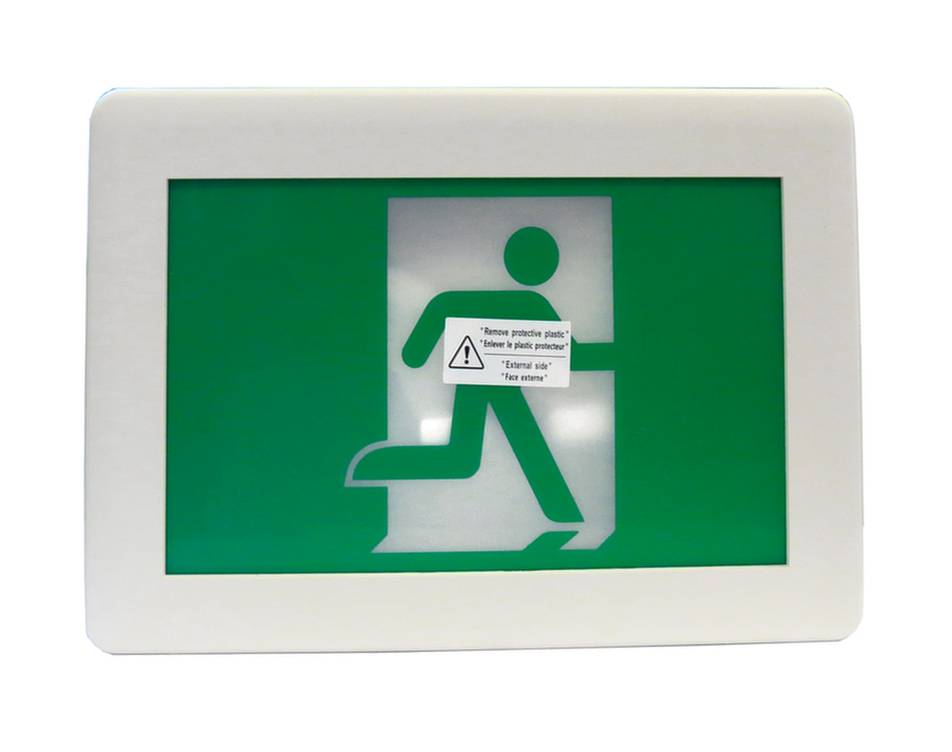As the name suggests, emergency lighting is designed to provide lighting and directions for evacuation in the event of an emergency or power failure. In regular buildings, the standard is 30 minutes of lighting.
Depending on the configuration of the premises, several models are available. Today’s models use LED lamps. Their energy consumption is lower and their lighting times are now longer than before. Furthermore, luminaries with the inscription Sortie or Exit are gradually being replaced by pictograms of a man running towards the direction of the exit. So called “Running man.” The luminaries use white on a green background as opposed to white on a red background for the older models.
The standard models do not have a built-in battery, so in principle, they must be connected to a unit to supply power in case of failure.
A quick reminder: these fixtures are powered in 2 ways:
1-by regular power (Hydro-Québec).
2-By a power source in case of failure, i.e. a nearby emergency lighting unit.
Exit with batteries.
This model is identical to the model without batteries. Its advantage is that it is equipped with a rechargeable lithium battery. In the event of a failure, the battery takes over. So, just plug the unit into a power source and connect the battery.
This model has the advantage of reducing installation costs because no wiring between the emergency lighting unit and the exit is required.
2 models on the market.
LUMR a model with a plastic housing that is obviously economical, but not necessarily very durable. Let’s say we find them fragile. I have observed recent installations in the field with units damaged during installation. In short, if you have a building and you plan to sell in the short term, this may be an option. In our opinion, it is better to pay a little more for a metal box. The cost of re-installation by an electrician is worth more than the difference between metal models.

LUMRMB the metal model, the best choice in our opinion. Durable and made to last. But obviously more expensive.

The regular LED units.
Available in 6 V and 12 volts. These stand-alone systems offer greater autonomy because of the use of the lead as a lamp. They come with a 120-Volt Ac power cord. They can be easily installed by simply attaching them and connecting them to a nearby power outlet. Some circuits can be powered by 347 Volts AC in this case you will need an electrician to make a direct connection.
The headlights are adjustable to mark emergency exit corridors. In addition, depending on the size of the battery installed, this system can power remote heads or exit lights.
The master units.
The function of this type of unit is to supply power to remote heads. With one or more master units, you avoid having several autonomous units each containing a battery to be replaced every 4 years. When it is possible to plan the installation of master units, you reduce the cost of periodic battery replacement. For apartment buildings or public buildings, you reduce the risk of vandalism or battery theft. In addition, the installation of remote heads is more aesthetically pleasing than a stand-alone unit.

On the other hand, the installation cost is higher, because the wiring must be planned before closing the walls preferably.
The choice of a master unit.
The majority of the circuits of these units. Have 2 outputs to the remote heads. As it is direct current, the wire is a load on the battery. Therefore, the objective is to use large gauge wire and to reduce the distance of the wire to reduce the load on the battery.
Determine the number of distance heads required, each LED head requires 3 Watts, the old one it 9 Watts.
e.g.: you need 15 double heads
15 X 2 (double) X 3 Watts/head = 90 watts/hr

To this at least 90 watts, add a little more to cover losses in the wiring. There are charters for the calculations, however, often the sizes of units sold depend on the batteries available on the market. Take a higher model to compensate for wiring losses.
If you would like more information on emergency lighting units and their maintenance, please contact Sylprotec Inc. Their rates are listed in the service section of their website. You will also be able to purchase the units as well as batteries and bulbs. They are available on their website in the fire protection section, under the emergency lighting tab.

Sylvain Patrice f.p.t
By the same author:
Presentation of the Polyflex® interior fire hose model from Mercedes Textiles Ltd.
Presentation of TRYME® hose manufactured by Mercedes Textiles Ltd.
How many fire extinguishers do I need to install and what size extinguisher should I choose?
Steps for performing an inspection on portable fire extinguishers.
